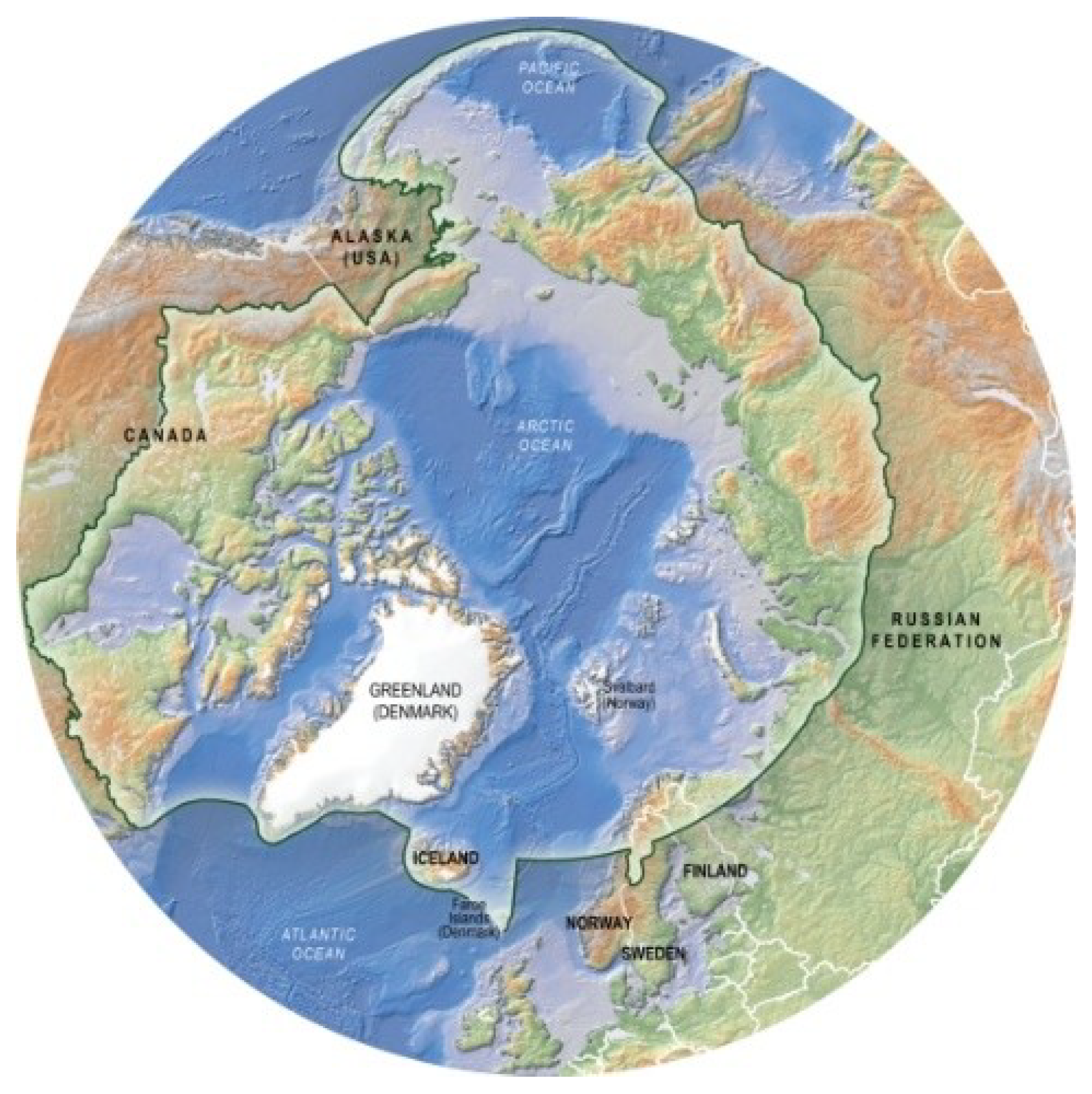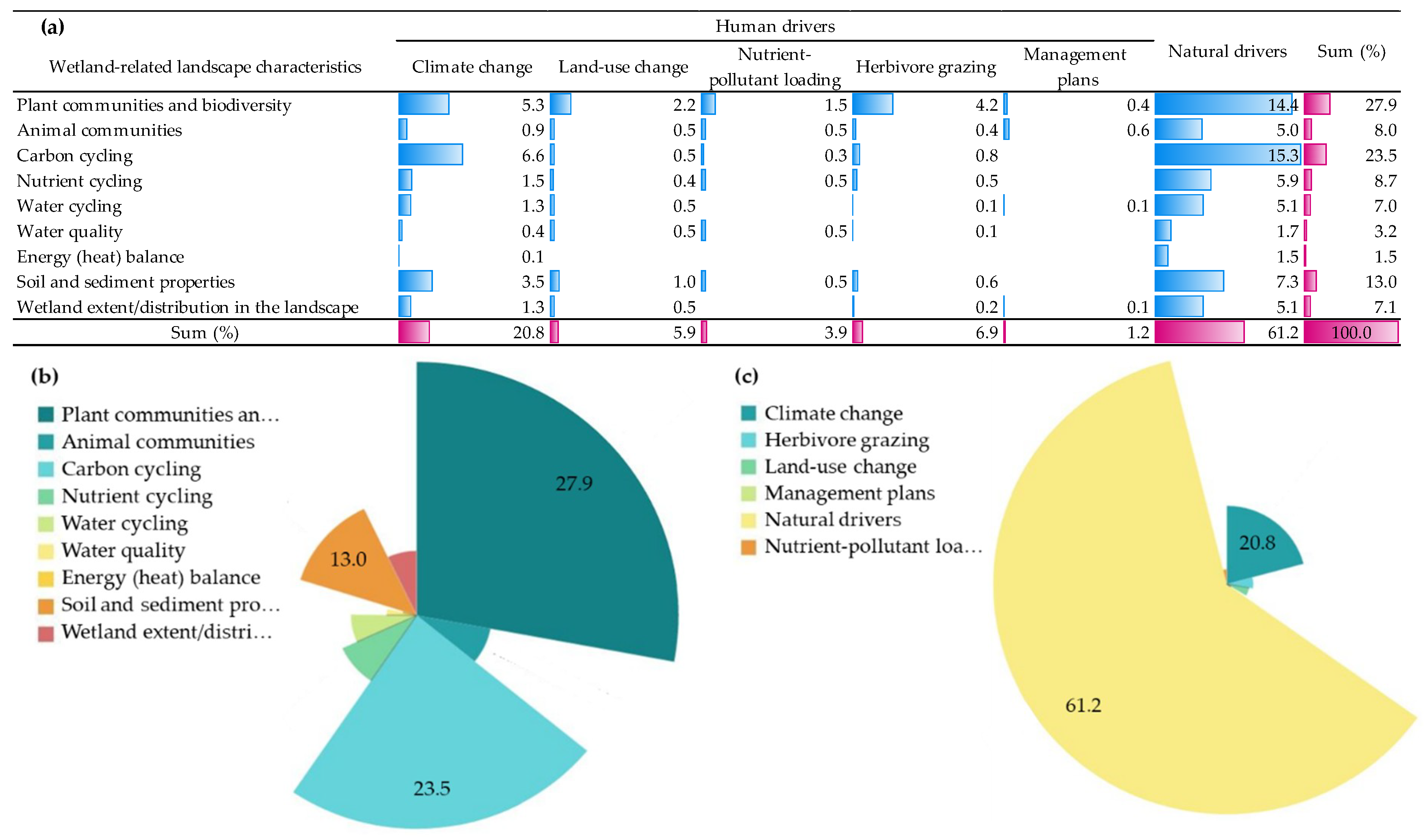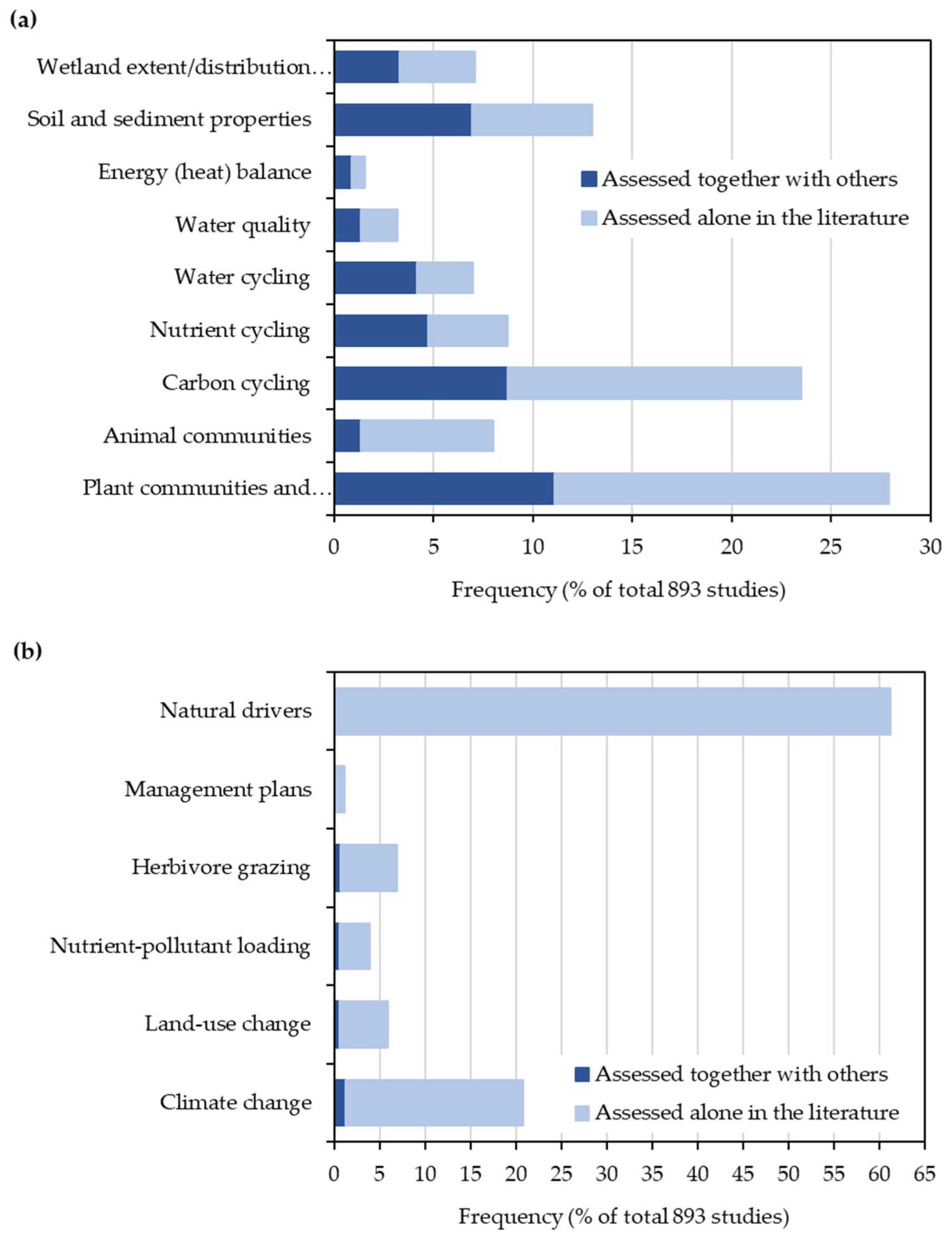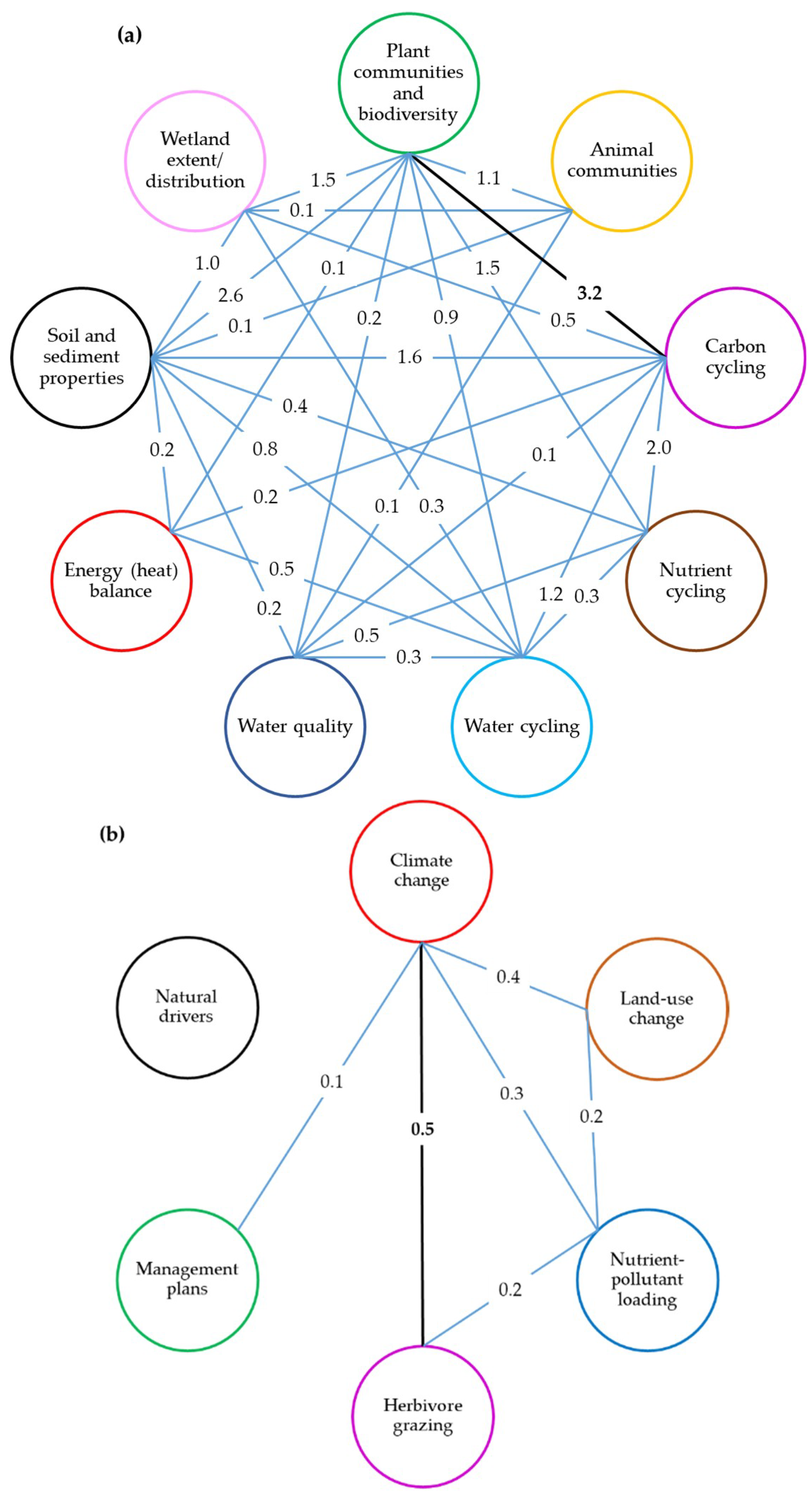Change Drivers and Impacts in Arctic Wetland Landscapes—Literature Review and Gap Analysis
Abstract
1. Introduction
2. Materials and Methods
3. Results and Discussion
3.1. Research Directions
3.2. Research Gaps
4. Conclusions
Author Contributions
Funding
Conflicts of Interest
References
- Häder, D.-P.; Kumar, H.D.; Smith, R.C.; Worrest, R.C. Aquatic ecosystems: Effects of solar ultraviolet radiation and interactions with other climatic change factors. In: United Nations Environmental Program: Environmental Effects of Ozone Depletion and its Interactions with Climate Change: 2002 Assessment. Photochem. Photobiol. Sci. 2003, 2, 39–50. [Google Scholar] [CrossRef]
- Michel, C.; Bluhm, B.; Gallucci, V.; Gaston, A.J.; Gordillo, F.J.L.; Gradinger, R.; Hopcroft, R.; Jensen, N.; Mustonen, T.; Niemi, A.; et al. Biodiversity of Arctic marine ecosystems and responses to climate change. Biodiversity 2012, 13, 200–214. [Google Scholar] [CrossRef]
- Wrona, F.J.; Prowse, T.D.; Reist, J.D.; Hobbie, J.E.; Levesque, L.M.J.; Vincent, W.F. Climate impacts on Arctic freshwater ecosystems and fisheries: Background, rational and approach of the Arctic Climate Impact Assessment (ACIA). AMBIO 2006, 35, 326–329. [Google Scholar] [CrossRef]
- Wrona, F.J.; Prowse, T.D.; Reist, J.D.; Hobbie, J.E.; Levesque, L.M.J.; Vincent, W.F. Key findings, science gaps and policy recommendations. AMBIO 2006, 35, 411–415. [Google Scholar] [CrossRef]
- The Romsar Convention. Ramsar Focuses on Arctic Wetlands. Available online: https://www.ramsar.org/news/ramsar-focuses-on-arctic-wetlands (accessed on 20 February 2019).
- Cohen-Shacham, E.; Walters, G.M.; Maginnis, S.; Janzen, C. Nature-Based Solutions to Address Global Societal Challenges; IUCN: Gland, Switzerland, 2016; pp. 1–32. [Google Scholar]
- The Ramsar Convention. Wetland Ecosystem Services Factsheet 0—An Introduction. Available online: https://www.ramsar.org/sites/default/files/documents/library/services_00_e.pdf (accessed on 31 March 2019).
- Davidson, N.C. How much wetland has the world lost? Long-term and recent trends in global wetland area. Mar. Freshw. Res. 2014, 65, 934–941. [Google Scholar] [CrossRef]
- Davidson, N.C.; Fluet-Chouinard, E.; Finlayson, C.M. Global extent and distribution of wetlands: Trends and issues. Mar. Freshw. Res. 2018, 69, 620–627. [Google Scholar] [CrossRef]
- Destouni, G.; Jaramillo, F.; Prieto, C. Hydroclimatic shifts driven by human water use for food and energy production. Nat. Clim. Chang. 2013, 3, 213–217. [Google Scholar] [CrossRef]
- Seneviratne, S.I.; Lüthi, D.; Litschi, M.; Schär, C. Land–atmosphere coupling and climate change in Europe. Nature 2006, 443, 205–209. [Google Scholar] [CrossRef] [PubMed]
- Karlsson, J.M.; Bring, A.; Peterson, G.D.; Gordon, L.J.; Destouni, G. Opportunities and limitations to detect climate-related regime shifts in inland Arctic ecosystems through eco-hydrological monitoring. Environ. Res. Lett. 2011, 6, 014015. [Google Scholar] [CrossRef]
- Thorslund, J.; Jarsjö, J.; Jaramillo, F.; Jawitz, J.W.; Manzoni, S.; Basu, N.B.; Chalov, S.R.; Cohen, M.J.; Creed, I.F.; Goldenberg, R.; et al. Wetlands as large-scale nature-based solutions: Status and challenges for research, engineering and management. Ecol. Eng. 2017, 108, 489–497. [Google Scholar] [CrossRef]
- Bring, A.; Destouni, G. Hydro-climatic changes and their monitoring in the Arctic: Observation-model comparisons and prioritization options for monitoring development. J. Hydrol. 2013, 492, 273–280. [Google Scholar] [CrossRef]
- Karlsson, J.M.; Lyon, S.W.; Destouni, G. Thermokarst lake, hydrological flow and water balance indicators of permafrost change in Western Siberia. J. Hydrol. 2012, 464–465, 459–466. [Google Scholar] [CrossRef]
- Streletskiy, D.A.; Tananaev, N.I.; Opel, T.; Shiklomanov, N.I.; Nyland, K.E.; Streletskaya, I.D.; Tokarev, I.; Shiklomanov, A.I. Permafrost hydrology in changing climatic conditions: Seasonal variability of stable isotope composition in rivers in discontinuous permafrost. Environ. Res. Lett. 2015, 10, 095003. [Google Scholar] [CrossRef]
- Lindwall, F.; Svendsen, S.S.; Nielsen, C.S.; Michelsen, A.; Rinnan, R. Warming increases isoprene emissions from an arctic fen. Sci. Total Environ. 2016, 553, 297–304. [Google Scholar] [CrossRef] [PubMed]
- Morison, M.Q.; Macrae, M.L.; Petrone, R.M.; Fishback, L. Seasonal dynamics in shallow freshwater pond-peatland hydrochemical interactions in a subarctic permafrost environment. Hydrol. Process. 2017, 31, 462–475. [Google Scholar] [CrossRef]
- Pavon-Jordan, D.; Santangeli, A.; Lehikoinen, A. Effects of flyway-wide weather conditions and breeding habitat on the breeding abundance of migratory boreal waterbirds. J. Avian Biol. 2017, 48, 988–996. [Google Scholar] [CrossRef]
- van der Kolk, H.J.; Heijmans, M.M.P.D.; van Huissteden, J.; Pullens, J.W.M.; Berendse, F. Potential Arctic tundra vegetation shifts in response to changing temperature, precipitation and permafrost thaw. Biogeosciences 2016, 13, 6229–6245. [Google Scholar] [CrossRef]
- Kalantari, Z. Wetlands as large-scale nature-based solutions: Protecting Kristianstad city from flooding and reduce nutrients before rivers reach the Baltic Sea. In Proceedings of the TERRAenVISION, Barcelona, Spain, 29 January–2 February 2018. [Google Scholar]
- Keesstra, S.; Nunes, J.; Novara, A.; Finger, D.; Avelar, D.; Kalantari, Z.; Cerda, A. The superior effect of nature based solutions in land management for enhancing ecosystem services. Sci. Total Environ. 2018, 610, 997–1009. [Google Scholar] [CrossRef] [PubMed]
- Erwin, K.L. Wetlands and global climate change: The role of wetland restoration in a changing world. Wetlands Ecol. Manag. 2009, 17, 71–84. [Google Scholar] [CrossRef]
- Roux, D.J.; Rogers, K.H.; Biggs, H.C.; Ashton, P.J.; Sergeant, A. Bridging the science-management divide: Moving from unidirectional knowledge transfer to knowledge interfacing and sharing. Ecol. Soc. 2006, 11, 4. [Google Scholar] [CrossRef]
- Galatowitsch, S.M. Natural and anthropogenic drivers of wetland change. In The Wetland Book; Finlayson, C., Milton, G., Prentice, R., Davidson, N., Eds.; Springer: Dordrecht, The Netherland, 2016; pp. 1–10. [Google Scholar]
- Calmels, F.; Froese, D.G.; Clavano, W.R.; Burn, C.R. Cryostratigraphic record of permafrost degradation and recovery following historic (1898–1992) surface disturbances in the Klondike region, central Yukon Territory. Can. J. Earth Sci. 2012, 49, 938–952. [Google Scholar] [CrossRef]
- Cameron, E.A.; Lantz, T.C. Persistent changes to ecosystems following winter road construction and abandonment in an area of discontinuous permafrost, Nahanni National Park Reserve, Northwest Territories, Canada. Arct. Antarct. Alp. Res. 2017, 49, 259–276. [Google Scholar] [CrossRef]
- Raynolds, M.K.; Walker, D.A. Effects of deglaciation on circumpolar distribution of arctic vegetation. Can. J. Remote Sens. 2009, 35, 118–129. [Google Scholar] [CrossRef]
- Pendea, I.F.; Ponomareva, V.; Bourgeois, J.; Zubrow, E.B.W.; Portnyagin, M.; Ponkratova, I.; Harmsen, H.; Korosec, G. Late Glacial to Holocene paleoenvironmental change on the northwestern Pacific seaboard, Kamchatka Peninsula (Russia). Quat. Sci. Rev. 2017, 157, 14–28. [Google Scholar] [CrossRef]
- Weedon, J.T.; Kowalchuk, G.A.; Aerts, R.; Freriks, S.; Röling, W.F.M.; van Bodegom, P.M. Compositional stability of the bacterial community in a climate-sensitive Sub-Arctic peatland. Front. Microbiol. 2017, 8, 317. [Google Scholar] [CrossRef]
- Quin, A.; Jaramillo, F.; Destouni, G. Dissecting the ecosystem service of large-scale pollutant retention: The role of wetlands and other landscape features. AMBIO 2015, 44 (Suppl. 1), 127–137. [Google Scholar] [CrossRef]
- Azcárate, J.; Balfors, B.; Bring, A.; Destouni, G. Strategic environmental assessment and monitoring: Arctic key gaps and bridging pathways. Environ. Res. Lett. 2013, 8, 044033. [Google Scholar] [CrossRef]
- Howison, R.A.; Olff, H.; van de Koppel, J.; Smit, C. Biotically driven vegetation mosaics in grazing ecosystems: The battle between bioturbation and biocompaction. Ecol. Monogr. 2017, 87, 363–378. [Google Scholar] [CrossRef]
- Bartlein, P.J.; Edwards, M.E.; Hostetler, S.W.; Shafer, S.L.; Anderson, P.M.; Brubaker, L.B.; Lozhkin, A.V. Early-Holocene warming in Beringia and its mediation by sea-level and vegetation changes. Clim. Past 2015, 11, 1197–1222. [Google Scholar] [CrossRef]
- Bombonato, L.; Gerdol, R. Manipulating snow cover in an alpine bog: Effects on ecosystem respiration and nutrient content in soil and microbes. Clim. Chang. 2012, 114, 261–272. [Google Scholar] [CrossRef]




| Category | Name | Description: Current Status and Changes in … |
|---|---|---|
| Wetland-related landscape characteristics | Plant communities and biodiversity | Vegetation composition, regime shifts, biodiversity, plant performance (production, growth, above- and below-ground biomass, resistance, species competition). |
| Animal communities | Animal population and species, animal size/productivity/distribution in the landscape, migration pathways. | |
| Carbon cycling | Carbon exchanges among soil, water, atmosphere, plants, including carbon-based greenhouse gases and compounds in animal and plant tissues. | |
| Nutrient cycling | Nutrient exchanges among soil, water, atmosphere, plants, including nitrogen- and phosphorus-based greenhouse gases and compounds in animal and plant tissues. | |
| Water cycling | Hydrology aspects, water and hydrogen and oxygen isotope exchanges among land and atmosphere (precipitation, evapotranspiration), runoff fluxes and storage changes. | |
| Water quality | Contaminant/pollutant concentrations, water quality effects on ecosystems and organisms. | |
| Energy (heat) balance | Heat balance and exchanges among land and atmosphere. | |
| Soil and sediment properties | Moisture/temperature/microorganisms/organic matter in the soil, permafrost and frozen layers, sediment/fossil assessments of historic changes. | |
| Wetland extent/distribution in the landscape | Area of water bodies, mapping and modeling of wetland landscapes, formation of peatlands. | |
| Human drivers | Climate change | Climate parameters, global warming, sea level rise, future climate projections. |
| Land-use change | Urban/agricultural/industrial developments in wetland landscapes. | |
| Nutrient-pollutant loading | Wastewater discharges to wetlands for treatment purposes, solid wastes in landfills, agricultural fertilization, heavy metal loads. | |
| Herbivore grazing | Grazing by native and non-native (migrant) herbivore species. | |
| Management plans | Protection and restoration efforts, flow regulation plans in wetland landscapes. | |
| Natural drivers | Natural processes within soil/water/atmosphere, plant and animal communities, interactions among components and processes in wetland landscapes. | |
© 2019 by the authors. Licensee MDPI, Basel, Switzerland. This article is an open access article distributed under the terms and conditions of the Creative Commons Attribution (CC BY) license (http://creativecommons.org/licenses/by/4.0/).
Share and Cite
Seifollahi-Aghmiuni, S.; Kalantari, Z.; Land, M.; Destouni, G. Change Drivers and Impacts in Arctic Wetland Landscapes—Literature Review and Gap Analysis. Water 2019, 11, 722. https://doi.org/10.3390/w11040722
Seifollahi-Aghmiuni S, Kalantari Z, Land M, Destouni G. Change Drivers and Impacts in Arctic Wetland Landscapes—Literature Review and Gap Analysis. Water. 2019; 11(4):722. https://doi.org/10.3390/w11040722
Chicago/Turabian StyleSeifollahi-Aghmiuni, Samaneh, Zahra Kalantari, Magnus Land, and Georgia Destouni. 2019. "Change Drivers and Impacts in Arctic Wetland Landscapes—Literature Review and Gap Analysis" Water 11, no. 4: 722. https://doi.org/10.3390/w11040722
APA StyleSeifollahi-Aghmiuni, S., Kalantari, Z., Land, M., & Destouni, G. (2019). Change Drivers and Impacts in Arctic Wetland Landscapes—Literature Review and Gap Analysis. Water, 11(4), 722. https://doi.org/10.3390/w11040722







